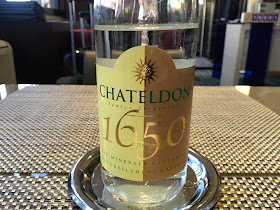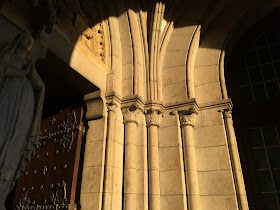Fraser Valley Parish Offers Oasis Filled with Gregorian Chant
By J.P. Sonnen
There has always been a strained relationship between
the ideal and the reality when it comes to sacred music in the liturgy.
Today a new generation of millennial Catholics is discovering
a fascination with the art of Gregorian chant, seeing it in a fresh light, a
mirror of the earthly liturgy as a foretaste of the heavenly liturgy.
Accentuating the appeal of chant for this new
clientele is the respect that it shows for the divine majesty as well as the
pastoral intention of edifying the faithful during the liturgical
services.
Art in the Liturgy
Catholic liturgy seeks to elevate the faithful to
prayer with every possible spiritual and artistic resource.
The concept of art in the liturgy and the liturgy as
art is not new, although it is taking a new turn in a variety of Catholic circles,
as many young people - including converts and non-Catholics - are beginning a re-evaluation
of the spiritual role of Gregorian chant as art.
Vatican Council II, a worldwide gathering of bishops
and other experts in the 1960s, declared that music is the highest form of art:
“The musical tradition of the universal Church is a treasure of immeasurable
value, greater even than that of any other art” (S.C., 112).
Catholic liturgies are famous for being enshrined in
beauty and a big part of this beauty is the musical patrimony.
In fact, all great art has instinctively selected
religious themes, and this has come to pass in the Church’s selection of
liturgical music.
Chant in the Fraser Valley
One parish in the lower mainland that is particularly
drawing faithful by its unique repertoire of liturgical music, with Gregorian chant
holding pride of place, is Saints Joachim and Ann in Aldergrove.
The Sunday Missa
Cantata Mass, also known as the “Gregorian Mass,” draws a diverse array of
faithful from across the Fraser Valley, including an occasional handful from
the U.S.-Canada border crossing.
For an older generation of Catholics, Gregorian chant
may seem a mere ornament of the past.
However, at Sts. Joachim and Ann it is seen as exactly what has been
called for by Vatican Council II.
The Council decreed in 1963: “The Church acknowledges
Gregorian chant as proper to the Roman liturgy: therefore, other things being
equal, it should be given pride of place in liturgical services” (S.C., 116).
Pastor and Choir Director
The pastor of Sts. Joachim and Ann, Fr. William
Ashley, is a native of St. John’s, Newfoundland. He grew up in the shadow of the great
Cathedral of St. John’s, having lived first-hand the deep liturgical life of a
cathedral parish in the 1950s, during a golden age of sacred music that included
Gregorian chant for Solemn Mass and Vespers.
His father, Dr. John Ashley, was a classical languages
scholar who made sure his son learned Latin and chant.
While studying in Rome as a seminarian for an advanced
graduate degree at the Angelicum, Fr. Ashley was accustomed to attending the
great liturgies of the Vatican in St. Peter’s Basilica, where he was ordained
priest in 1977.
From his experience and knowledge of chant, Fr. Ashley
knew that because of the nature of the technical requirements of chant, a
chosen group of singers under the direction of a professional musician would be
necessary in his parish.
Mr. Alexander McCune stepped forward and was tapped to be the chant master at Fr. Ashley's parish. Alex, a gifted conductor, director, teacher, vocal coach and performer, also happens to be a convert from Protestantism.
A native of Edmonton, Alex became involved as a child in song and piano. While studying at Our Lady Seat of Wisdom Academy in Ontario, he began conducting and accompanying in the sacred choral program, which led to his expertise in chant.
For centuries the faithful have sung simple Gregorian
chant melodies. This work has continued
by the cultivation of chant in parish choirs, especially in small groups, as
seen here.
Death of Chant and Revival
Religious art has always been subjected to the same
exigencies as any other art, including that of the fluctuation of artistic
taste.
Fifty years ago the popularity of Gregorian chant was
eclipsed by social changes that were provoked by the cultural revolution of the
1960s and thus it lost its central place in the Western Church.
The 1960s trend toward general popular culture,
founded on rationalist and political principles that raised emotion to the same
level as reason, resulted in new norms for simpler music.
Many unjust and sweeping generalizations and
reproaches were used to disband choirs and do away with organ music, largely
leaving choral music and chant by the wayside.
Every period of history has set special tasks for
music in relation to worship. History
proves that valid forms of liturgical music need a long maturation period and
outlive passing trends and fads unduly influenced by popular culture.
Latin and Active Participation
Enter Latin. The
reason the Latin Church avails the forms of Latin declamation in sacred music –
the distinct projection of Latin words set to music - is because the Church has
not yet found a convincing melodic stylization for other languages, a
stylization that would match the current repertoire of sacred music in Latin.
Recent studies have shown that, concerning music,
there is as much active participation in experiencing music as in singing
oneself.
This is because participation does not reside solely
in outer activity, but also in the inner receptivity which is promoted by the
power of sung music.
While listening and experiencing are also forms of
active participation, they are all the more penetrating when liturgical expression
is authentically artistic.
A one-sided interpretation of active participation of
the people gradually developed in the twentieth century, viewing music in the
liturgy as something solely exterior (for example, the entire congregation singing
every hymn together), which has historically never existed.
The laity contribute, by virtue of their baptismal
character, both through internal and external participation a full and active
participation. All the baptized, in all
their Christian actions, participate in the worship offered by Christ.
The authenticity and appeal of chant as the norm for
Solemn Mass in the Roman rite is most certainly a form of participation on
multiple levels.
History of Chant
The integral unity between liturgy and the liturgical
chants which had been developed in primitive Christianity and become evident in
the Gregorian melodies is closely connected with their liturgical functions.
The organic unity of chant did not result from a flash
of genius, but from slow growth and steady evolution, from centuries of
grappling with the problem of the spirit and form of liturgical singing.
Even in early Church and synagogue worship, the
offices of cantor, soloist, schola and choir had been established, because it
was believed that the community as a whole had a duty to create and bring into
being liturgical music worthy of God and of the highest artistic merit, while
at the same time proper to the edification of the faithful.
Although chants executed by the congregation have
historically been limited by the very nature of the technical requirements of
the music, the acclamations and the simple chants have always remained the charge
of the congregation.
The Catholic Church teaches that sacred music should
reflect the artistic expression of the period while at the same time remaining
the expression of the religious soul of man, distinct from secular forms.
Gregorian chant is not secular; it evolved from
different roots, above all from Jewish worship – a prime example is Psalmody,
the chanting of the Psalms of David.
Liturgy as Solemnity
The better the quality of the sacred music, the closer
the choir becomes the sublime interpreter of the congregation, bringing to the
congregational singing a quality of expression that by itself it could never
achieve.
The best musical pageantry in the liturgy of the East
and West is justified by the idea that divine worship must be a majestic solemnity
which tries to imitate by the joy and quality of the music the adoration of the
heavenly hosts.
This is what draws and inspires young Catholics to
attend the Gregorian Mass in Aldergrove, where the fullness of chant is being
fostered, emitting eternal impulses for inspiration and stimulation.
A very respected professional musician from Germany, Abbot
Urbanus Bomm of Maria Laach Abbey, had this to say of chant: “It may be unpleasurable to have to face
Gregorian chant as a norm, but we should endure it. Imitations will not do. Genius and skill need deeper roots, and a
universally accepted voice culture requires the same patience and effort as
agriculture – and God’s blessing in due time.”

















































